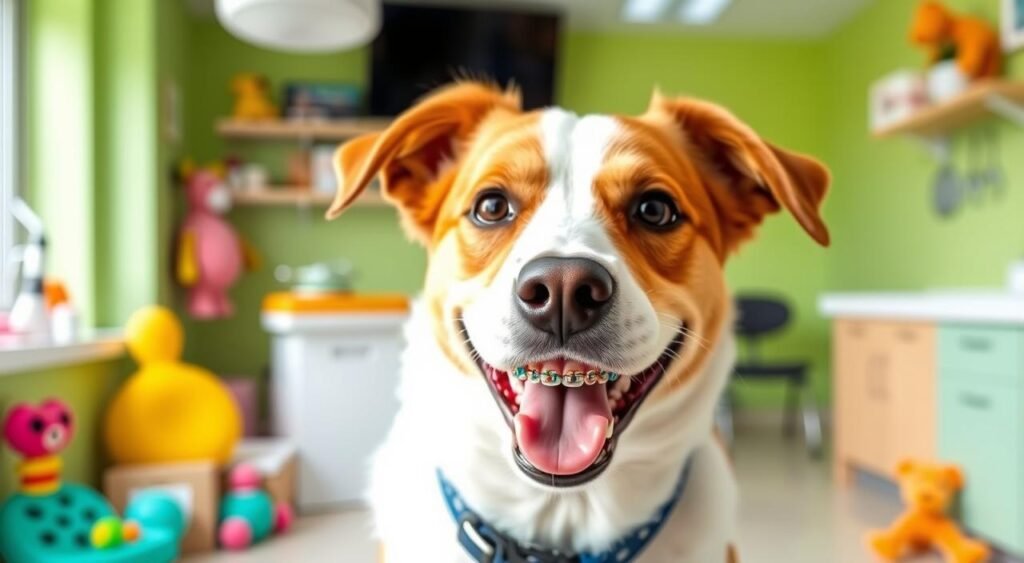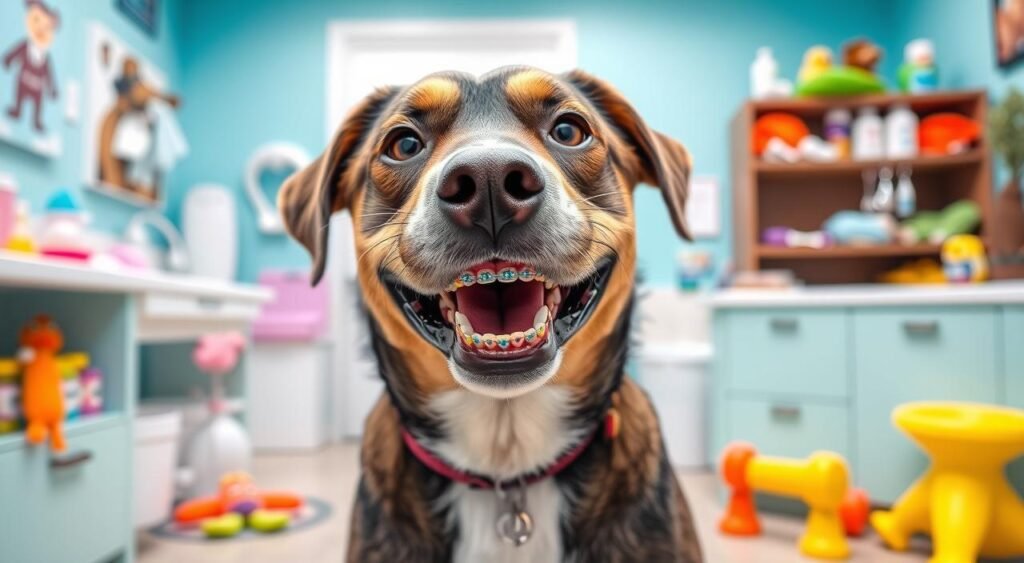Can your furry friend get a dental makeover? Dog braces teeth are now a thing in vet dentistry. This new trend in dog orthodontics is making pups’ smiles healthier and more comfy.
Vet dentists are giving dogs orthodontic treatments for bad bites. These bad bites can hurt and lead to health problems if not fixed. Pet owners are spending $2,000 to $5,000 to make their dogs’ teeth healthier.
The American Veterinary Dental College has rules for fixing pets’ teeth. They want to make sure pets’ bites are healthy and work right. This is key for breeds like Bulldogs and Shih Tzus, who often have bad bites.
There are many ways to fix your dog’s teeth, from old-school braces to new rubber ball therapy. It’s important to keep up with vet visits and feed your dog soft food during treatment. Fixing dental problems early not only makes your dog’s smile better. It also makes them healthier and happier.
Understanding Canine Dental Malocclusion
Canine malocclusion is when a dog’s teeth don’t line up right. This can make your pet uncomfortable and unhealthy. Treatments like dog braces for overbite and underbite help fix this.
Common Types of Malocclusion in Dogs
There are many types of malocclusion in dogs:
- Overbite: The upper jaw sticks out too far
- Underbite: The lower jaw sticks out too far
- Crossbite: Some teeth don’t line up right
- Wry bite: One jaw grows differently than the other
Signs Your Dog Might Need Orthodontic Treatment
Look out for these signs your dog might need dental help:
- Teeth that don’t line up
- Hard time eating or chewing
- Rubs or paws at their mouth
- Bad breath or too much drooling
Impact of Untreated Malocclusion on Canine Health
Untreated malocclusion can cause big health problems. These include gum disease, tooth decay, and constant pain. It can even make it hard for your dog to eat.
Getting early treatment, like dog braces, can stop these issues. It can also make your dog’s life better.
Dog Braces Teeth: Options and Procedures
Canine orthodontics has made big strides since the 1980s. Now, veterinary dentistry offers many ways to fix dental problems in dogs. Let’s look at the different types of dog braces and procedures available.
Traditional Metal Braces for Dogs
Dogs can wear metal braces just like humans. These braces fix issues like teeth crowding and overbites. The cost of dog braces can be between $1,500 and $4,000, based on the problem’s complexity.
Inclined Orthodontic Appliances
For some dogs, inclined orthodontic appliances are a good choice. These devices slowly move teeth into the right spot. Treatment can take 2 to 3 months, with regular check-ups needed.
Crown Amputation with Restoration
In some cases, moving teeth isn’t possible. Then, crown amputation with restoration might be needed. This involves shortening the crown and using a dressing to keep the tooth alive. It’s used when other methods won’t work.
Remember, dog braces do more than just look good. They also help your pet’s dental health and comfort. If you see dental problems in your dog, talk to a vet dentist. They can help find the best treatment.
The Process of Fitting Braces on Dogs
Fitting dog braces teeth is a special task in vet dentistry. It begins with a detailed check to see if your dog can get braces. Your vet will look at your dog’s health and teeth.
The actual fitting happens while your dog is asleep. It usually takes 30 to 90 minutes. First, your dog’s teeth get a deep clean to remove plaque and tartar. This is key for the braces to stick well.
Then, the orthodontic devices are carefully put on your dog’s teeth. These might include:
- Elastic chains
- Palatal expanders
- Acrylic splints
The choice of device depends on your dog’s needs. These tools help move your dog’s teeth into the right spot slowly. The treatment can last 6 to 12 months, with many check-ups and tweaks needed.
The cost of dog braces can be from $1,500 to $5,000. Some pet insurance might help pay for it. Remember, this treatment is for serious dental problems that could really hurt your dog’s life quality.

Aftercare and Maintenance for Canine Orthodontics
Proper dog braces aftercare is key for a successful treatment. Canine orthodontics need your full attention. This ensures your dog’s comfort and the treatment’s success.
Dietary Adjustments During Treatment
Your dog’s diet must change during orthodontic treatment. Soft, wet foods are best to avoid discomfort. Also, keep chew toys and bones away to prevent bracket damage.
Oral Hygiene for Dogs with Braces
Good oral hygiene is vital for dogs with braces. Brush their teeth regularly, paying extra attention to brackets and gums. Your vet might also recommend an oral antiseptic rinse.
Follow-up Appointments and Adjustments
Regular vet visits are needed for adjustments and checks. Dr. Jennifer Lynn, a canine dentistry expert, stresses the importance of these visits. Some dogs may need retainers after their braces are removed.
- Treatment typically lasts two to three months
- Older dogs may require longer treatment periods
- Some dogs can be fitted with adjustable appliances for at-home tightening
With the right care, canine orthodontics can greatly improve your dog’s dental health. Always follow your vet’s advice for the best outcomes.
Conclusion
Dog braces teeth are a new and exciting way to help pets. They have a high approval rate of 4.9 out of 5 from 9 votes. This shows they are becoming more popular among pet owners.
Your dog’s teeth are very important. Adult dogs have 42 teeth, and puppies get all their teeth by 6 months. Keeping their teeth healthy is key.
Problems with teeth in dogs often start when they are 4-6 months old. Getting help early is very important. Treatment can last 2-3 months and cost between $1,000 and $4,000.
Going to the vet regularly is a must during treatment. This helps make sure everything is going well. The best time for treatment is when your dog is growing fast.
Studies on dog teeth have shown great results. New treatments have fixed teeth problems in dogs. This not only makes their teeth look better but also helps them eat and behave better.
By choosing these new treatments, you’re making a big investment in your dog’s health. You’re helping them live a happier and healthier life.
FAQ
What is canine dental malocclusion?
Canine dental malocclusion is when a dog’s teeth don’t fit right in their jaw. This can cause pain and health problems. It includes issues like teeth pushed towards the tongue, overbites, and underbites.
What are the signs that my dog might need orthodontic treatment?
Signs your dog might need braces include misaligned teeth and trouble eating. They might also show signs of pain or damage from teeth rubbing together.
What are the options for dog braces teeth?
There are many options for dog braces. These include metal braces, ceramic brackets, and special appliances. There are also options like PetAlign for aligning teeth.
How much do dog braces teeth typically cost?
Dog braces can cost between $2,000 and $5,000. This depends on how complex the case is and if anesthesia is needed.
What is involved in the process of fitting braces on dogs?
Getting braces involves a dental cleaning and applying brackets and elastic chains under anesthesia. Sometimes, more appliances like expanders or splints are needed.
What dietary adjustments are needed during canine orthodontic treatment?
Dogs need soft, wet foods during treatment to avoid pain and bracket damage. They should also avoid chew toys and bones.
How often do dogs need follow-up appointments during orthodontic treatment?
Dogs need regular check-ups, usually every week or two. These visits help adjust the braces and check on progress.








